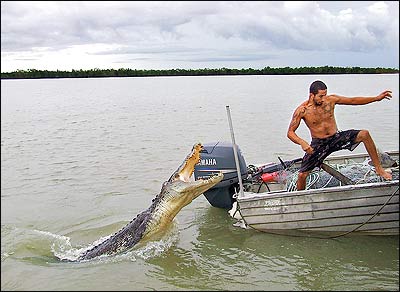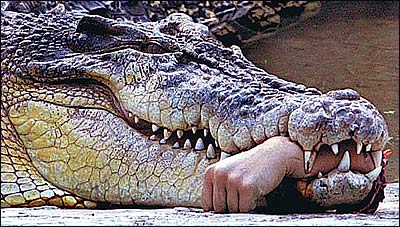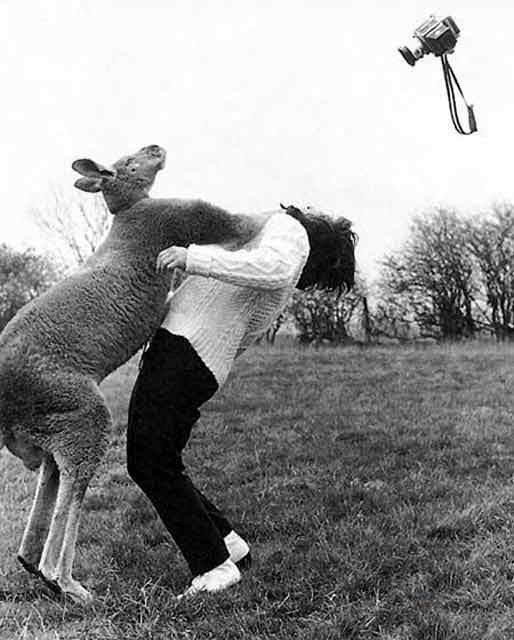What Beasts Are Thinking
Mad Cows (and Livid Lambs)Revenge is sweet and not fattening. - Alfred Hitchcock by Will Storr Marauding elephants, aggressive sea lions, snap-happy crocodiles... In a tiny village in rural Assam, two terrified children will tonight sleep in a tree house. It doesn't matter how much their mother scolds them; there's no way they're going to bed down there. Not after what happened. They can still remember that night, of course - being picked up by their mother, and how hard she covered their mouths with her hands to stop them screaming. They can remember the other sounds, too.
A saltwater crocodile launches itself at a holidaymaker in Australia The elephants had come in from the forest again. Then they saw one, a vast dark hulk looming out of the black towards their door. Their Dad tried to push it away. That's when the elephant carried him round the side of the house and killed him. Elephants haven't always behaved like this. But in recent years, in India and all over Africa, too, some menacing change has come over them. And not just elephants - it's almost any species. This disquieting pattern has only recently been detected, in part because it is so disparate and weird. But it's now widely accepted that the relationship between humans and animals is changing. One of the world's leading ethologists (specialists in animal behaviour) believes that a critical point has been crossed and animals are beginning to snap back. After centuries of being eaten, evicted, subjected to vivisection, killed for fun, worn as hats and made to ride bicycles in circuses, something is causing them to turn on us. And it is being taken seriously enough by scientists that it has earned its own acronym: HAC - human-animal conflict. It's happening everywhere. Authorities in America and Canada are alarmed at the increase in attacks on humans by mountain lions, cougars, foxes and wolves. Romania and Colombia have seen a rise in bear maulings. In Mexico, in just the past few months, there's been a spate of deadly shark attacks with The LA Times reporting that, "the worldwide rate in recent years is double the average of the previous 50." America and Sierra Leone have witnessed assaults and killings by chimps who, according to New Scientist, "almost never attack people." In Uganda, they have started killing children by biting off their limbs then disembowelling them. There has been a surge in wolf attacks in Uzbekistan, Tajikistan, Russia and France. In Australia, there has been a run of dingo killings, and crocodile violence is up. In Beijing, injuries from cats and dogs have swelled by 34%, year-on-year. In America, the number of humans killed by pet dogs has increased sharply since 2000. In Australia, dog attacks are up 20%. In Britain, nearly 4,000 people needed hospital treatment for dog bites in 2007, a figure that has doubled in the past 4 years. In Bombay, petrified residents are being slaughtered in ever-increasing numbers by leopards, leading J C Daniel, a leopard specialist, to comment, "We have to study why the animal is coming out. It never came out before." In Edinburgh, in June, there was a string of bizarre fox attacks - a pensioner was among the victims. In Singapore, residents have been being terrorised by packs of macaques. Sharon Chan, a national parks official, told reporters, "It's a very weird situation."
A crocodile attack The numbers are disturbing enough, but the menacing changes in behaviour are especially worrying to scientists. In Australia, the biologist Dr Scoresby Shepherd - who pointed out that in areas where shark attacks used to happen every 3 - 4 decades, they are now taking place at least once a year - has suggested that sharks are switching their prey to humans. In Los Angeles, Professor Lee Fitzhugh has come to the same conclusion about mountain lions. In San Francisco, a spate of sea lion assaults lead one local to comment, "I've been swimming here for 70 years and nothing like this has happened before." In Cameroon, for the first time, gorillas have been throwing bits of tree at humans. They're using weapons against us. It's easy to see why some suspect revenge. The theory that the animals of the 3 elements are conspiring against us gained popularity in 2006, when the Australian television presenter Steve Irwin was speared through the heart by a stingray off the north Queensland coast. In the aftermath, the phrase "freak accident" was used in news reports. When, just 6 weeks later, the same thing happened to James Bertakis, of Miami (he lived only because, unlike Irwin, he didn't pull the barbed sting out), people started wondering. Then, in March this year, Judy Kay Zagorski was boating on the Florida Keys when a stingray leapt from the water and fatally struck her in the face. Any sane person might decide that his theory, which posits that beasts are working in concert to take revenge on humans, is insane. But in the regions where the most research into HAC is being carried out, scientists have concluded that revenge for our myriad barbarities could indeed be a motive. All over Africa, India and parts of south-east Asia, elephants have started attacking humans in unprecedented numbers. Not just killing - they're rampaging through villages and stomping crops, terrorising local populations in any way they can. "What's happening today is extraordinary," Dr Gay Bradshaw, a world authority on elephants, told reporters in 2006. "Where for centuries humans and elephants lived in relatively peaceful co-existence, there is now hostility and violence." Bradshaw is the director of the Kerulos Centre for Animal Psychology and Trauma Recovery, in Oregon. "When you see reports of elephants running into crops or attacking people, they're highly stressed," she tells me. "And there are multiple stressors - violence, lack of food, lack of water; their families are being broken up; their society is collapsing. All of these things are human-derived."
Eric Nerhus was swallowed up to the waist by a shark Bradshaw describes the elephants as being "under siege" from the locals. But the violence against humans has increased so suddenly, and reached such levels, that these traditional factors aren't thought to be sufficient to explain it. Bradshaw and her colleagues now think that there's been a massive, pan-species psychological collapse throughout the world's pachyderms. In essence, we're witnessing the dysfunctional shenanigans of a generation of depraved elephants. These are individuals who have become psychologically fractured after being orphaned at a developmentally delicate age or are suffering from post-traumatic stress disorder after watching their families being slaughtered. "You could make a parallel between elephants and people who are undergoing genocide and war," Bradshaw says. "They've gone through massive killings and many have sustained culls or severe poaching, so they've witnessed the violence and they're traumatised. It's critical to understand that when you have an experience at a young age, or through adolescence or even as an adult, it enters into the brain. In other cases, the normal rearing process is disrupted or conducted by distressed parents, so you're creating individuals who are mentally challenged." Such claims might be dismissed as so much Disneyfied anthropomorphism if Bradshaw did not have the observational, psychological and neuroscientific evidence to back them up. And, she says, it might not be just in elephants that this critical point has been breached. "I think we're well past the critical point," she says. "Well past. People are starting to notice these atypical behaviours in an array of species." Of the question of elephant revenge, though, she is more cautious. "Put yourself in an elephant's shoes. What's it like living in Africa or Asia when you're surrounded by an active threat, not just to you but to your family? Let's take, for example, one of the things that's happening in Africa. Females are starting to charge lorries. Why? It's hard to understand the motive. Perhaps she's traumatised. Perhaps it's pre-emptive - they may have a gun. It may be self-defence. And other times it may well be revenge. It's not that I don't think elephants have the capacity." Dr Marc Bekoff, a leading ethologist, agrees. "We need to be careful when using that sort of language," he says. "But I don't think there's any doubt that, in certain situations, animals show revenge." At first he thought it was a dream; that shuffling, that banging that bulged out of the darkness around him. By the time Michael Fitzgerald had roused himself and put on his slippers, he decided it was burglars. They were in the garage. He crept forward, readying himself for what awaited behind the electric door that was slowly, noisily rising. He peered in. It was a badger. Just a badger! He'd never seen one so close before. The badger looked up, then slowly, calmly walked up to him. "Pam!" he called to his wife. "Get a camera!" Two minutes later, blood from his arm was spattered over his front door. "It was some kind of hell," Fitzgerald, from Evesham, told the BBC, in 2003. "His razor-blade teeth were around my arm." Even after he had shaken if off, it gave chase, biting his legs and arms. "I never envisaged I would be seeing my own insides," he said. The badger then embarked on an 18-hour rampage around the town. Stories like these remind us that there are millions of beasts armed with teeth and stingers, who can out-sniff, out-run, out-fly, out-fight and out-bite every one of us. The eerie truth is that, right now, we're surrounded. As a species, we've been at the top of the food chain for so long, we've forgotten that humans are mere anthropoid apes and, in distant millennia, we had to fight the feral armies to get here. In our hubris, we imagine we're an animal apart. For centuries, we've been told by priests and scientists that animals are not much more than unfeeling, unthinking, unselfconscious automatons. They're a gift from God, and their purpose is to have paracetamol rubbed into their eyes, to be turned into fancy trousers to be stuffed with nuts on His birthday. Many mainstream scientists still warn against anthropomorphism. But it doesn't stop the many people who are secretly wondering what's really going on behind those inscrutable black eyes? Are the birds talking about us? Do lobsters sulk? Can one moose love another? The more scientists have discovered about the inner lives of animals, the more troubling and strange things have become. "Things are really changing," acknowledges Bekoff. "There's a lot of new behavioural research, a lot of new neuroscience research that demonstrates they are far more complex than was thought. We're not inserting into animals something they don't have."
A man is mauled by a bear in Kashmir, India Bekoff describes the sound Darwinian logic beneath this gigantic paradigm shift. Simply, if our brains have developed the capacity for a rich emotional inner-life over the millions of years they've been evolving, then why not theirs? "If you believe in biological continuity then, if we have emotions, they have emotions. If we have a heart, they have a heart." But there are still many people, such as Prof Peter Carruthers, of the University of Sheffield, who would consider this to be misguided sentimentality. In his book The Animals Issue, he insists that animals don't consciously feel pain, and therefore "make no real claims on our sympathy." When vets and vivisectionists anaesthetise their subjects, the argument runs, they're indulging in schmaltzy, greetings-card reasoning. Dr Paul McDonald, of the Centre for the Integrative Study of Animal Behaviour, in Sydney, also warns against the sort of talk Bekoff persists in. "There's a temptation to put human emotions into animal interactions, which I think is not the way to go," he says. "The danger is it'll shape your interpretations. Take noisy mynah birds, for example. They have a dominance hierarchy, so there's often aggressive interactions where one bird appears to beat the other up. Through human glasses that could be a punishment or something along those lines, where in reality it's about maintaining social rank." But McDonald's worldview and his observations seem at odds. "Altruism remains a conundrum," he says. "Why do you have so many animals helping? Particularly animals that aren't related. If you're helping to raise a nephew, at least you're replicating part of your genome. But when you're raising a totally unrelated individual, that becomes much more difficult - and that happens quite commonly." He points to bell mynah birds, which feed chicks in many nests at the same time, even though they may have chicks in their own nest. "That seems very, very strange." Even stranger is the incident Gay Bradshaw reports, of a hero crow helping hungry kittens. "The crow would go get worms and fly down and feed them to these starving kittens. Eventually, they became friends and played together." And altruism isn't the only documented animal behaviour that was once thought to have been purely human. Take empathy and Kuni, the bonobo. Kuni watched a starling fly into the glass wall of its enclosure and thud to the floor. He picked it up, climbed to the top of the tallest tree, stretched the bird's wings out and launched it back into the air. When it thudded back down again, the ape climbed back down and stood over it for a long time. And here's another complex mental state - grief. Elephants, for example, stand vigil over the bodies of dead companions for a week, before gently covering the corpse with earth. They then visit the gravesite for years afterwards, taking turns to handle the bones. "They lift the bones with incredible sensitivity," says zoologist Dr Tammie Matson, the WWF's human-animal conflict specialist. "It's as if they can somehow read something about the elephant that was once attached to them." Bekoff, meanwhile, has witnessed a magpie funeral. "I saw a dead magpie on the road and stopped to look at what was happening. One magpie went in and touched the corpse and backed away, another magpie went in and backed away, then another flew off and brought grass back and laid it around the corpse, then another did the same." And then there was the fox funeral. "This fox had been killed by a mountain lion and the next day a female fox found the carcass. She covered it up with leaves and pine needles and dirt and branches. She stamped it down and stood over it." British neuroscientists have found that sheep can remember at least 50 ovine faces, even when they've been separated for years. Cows, meanwhile, get anxious. John Webster, professor of animal husbandry at Bristol university, has discovered that they have between 2 and 4 best friends. They also have enemies, bearing grudges for years. Perhaps the evolutionary achievement humans are proudest of - and is thought by some to be the very seat of consciousness - is language. But even chickens talk to each other. "If a hawk flies over a chicken, it gives a particular call," says Dr McDonald, "whereas if it's a fox, it's a different call." Indeed, according to Bekoff, many birds have regional dialects and wolves have, "very complex communication systems. A wolf's tail has 13 to 15 positions which send different messages. And when you combine the tail position, ear position, gait, odour and sound, you've got a kaleidoscope of different modes of communication." And if there's any remaining doubt that animals have the capacity to feel anger at humans, take the case of traffic-jamming rhesus monkeys. When a baby monkey had its legs crushed by a car in Tezpur, India, 100 others encircled it and blocked the road. Onlookers described the monkeys as "angry," while a shopkeeper said, "It was very emotional. Some of them massaged its legs. Finally, they left the scene, carrying the injured baby with them."
A lioness gnaws on a man’s body at Kiev zoo in 2006 Are we committing the sin of anthropomorphism by calling the monkeys angry? "Let the philosophers debate that if they want to," says Bekoff. "We've got too many other things we need to deal with without worrying about whether we're being anthropomorphic." If revenge is one possible motive behind the dramatic global rises in animal-on-human violence, it's surely a minor one. We shouldn't be surprised when animals play nasty. They're all at it. In 2002, scientists at Michigan State University discovered that even bacteria engage in chemical warfare. And even species that we believe to be benign turn out to be ruthless. Robins, for example, fight each other to the death. And in January, marine scientists released footage of gangs of dolphins repeatedly ramming baby porpoises, tossing them in the air and chasing them to their death. Researchers in Scotland described "perhaps the worst example of inter-specific aggression any of us has ever seen. This young female had the life beaten out of her." Worse, it has been discovered that they're fond of infanticide. The rise in animal-on-human violence turns out to have several causes which initially appear separate but are all linked. Dr Matson is clear on the elephant problem; both its causes and its nature. When she arrived in Bushmanland, Namibia, 15 years ago, an elephant had just killed an elderly woman. "That sort of thing happened pretty regularly," she says. When Matson arrived in Assam, last year, she met a family who had suffered similarly. "It all comes back to humans, ultimately. It's a competition for resources. You've got this clash between the world's most dominant primate and the world's largest terrestrial animal." Even pet dogs and their considerably less cuddly cousins, dingos, have been clashing with humans. Dr Paul McGreevy, a British veterinary scientist, uses the run of dingo attacks in Australia's Fraser Island as an example. In April 2001, a 9-year-old boy was killed and his 7-year-old brother injured after they were chased and pounced on by the dogs. It was said to be only the 2nd attack in modern times. Then, just 6 days later, 2 British backpackers were bitten on the legs and buttocks. "The first step is habituation, a loss of fear," McGreevy says. "Familiarity breeds a form of contempt. If the animals are no longer frightened of humans they begin to hang around instead of running away. In Fraser Island, tourists became a predictor of food. The 2nd possibility is that animals learn to fear humans under certain circumstances. This means they're coming closer to humans, but are prepared to defend themselves. When they're primed by this arousal, they can have lowered thresholds for aggression and produce hair-trigger responses." When a wild animal is just about not-scared-enough to approach a human, but still has enough fear heating its blood to unleash a frenzy at the slightest provocation, it's in a uniquely dangerous state. It's not hard to see how McGreevy's dingo theory could be applied to cougars, mountain lions, boars, bears and wolves, all of whom are having their traditional habitats and feeding grounds annexed. Scientists studying the increase in big-cat attacks in America have suggested that their growing familiarity with us is leading them to view humans as hotdogs in trousers. "There has been a huge increase in the opportunities pumas have to observe people," Lee Fitzhugh, of the University of California, told New Scientist. "Cats have to learn what's prey and what's not - it's not instinctive. They spend time observing a strange creature before they decide how to classify it." Researchers think the same process might be responsible for the increase in shark attacks: the popularity of surfing and shark-watching dives give the fish more chance to see that we're basically harmless and possibly tasty. Perversely, conservation may also have worsened the situation. Elephant numbers are up as is the crocodile population. In Australia, where croc-hunting was banned 30 years ago, numbers of the most deadly saltwater variety have risen from 5,000 in the early 1970s to more than 70,000. What all these problems have in common is, of course, us. We're in their face a lot more these days. And that face is full of teeth. According to Gay Bradshaw, we shouldn't be asking why they're turning on us. A more reasonable question would be, why aren't they attacking us more? "Animals have the same capacity that we do, in terms of emotions and what we consider to be high-mindedness and moral integrity. In fact, I'd argue they have more, because they haven't done to us what we've done to them. That's a sobering thought. It's amazing that all the animals are as benign as they are. It's amazing their restraint. Why aren't they picking up guns?" Source: telegraph.co.uk 10 August 2008
Are even the bees getting back at humans for poisoning them? Three Treated for Suspected Toxic Honey PoisoningA 32-year-old man is in satisfactory condition in Thames Hospital after being one of three people to be treated for symptoms of toxic honey poisioning in the Coromandel. A 38-year-old woman and her 3-year-old son have been discharged from the hospital. The New Zealand Food Safety Authority and Waikato District Health Board today advised all consumers who bought comb honey from the Coromandel area in recent days not to eat the honey. On Thursday the 3 all ate comb honey bought from the Coromandel area and hours later they started vomiting. The 32-year-old man was the first treated in Thames Hospital's emergency department. He and the 3-year-old both had seizures, Waikato District Health Board spokeswoman Mary Anne Gill said. "The honey may have had high levels of tutin toxin which if consumed can result in symptoms include vomiting, delirium, giddiness, increased excitability, stupor, coma and violent convulsions," she said. A number of people have been killed, incapacitated and hospitalised over the years from eating toxic honey. The last recorded case from commercial honey was in 1974 involving 13 patients. There have been 9 cases since 1974 with the last known poisoning occurring in 1991 in the Eastern Bay of Plenty area. Two poisonings have been caused by comb honey produced by hobby beekeepers in the Marlborough Sounds in 1982 and 1983 and the highest levels of tutin ever measured in honey were produced in this area. Symptoms usually develop within 3 hours of consumption. These honey toxins can be lethal, or make a person very sick. As little as one teaspoon (approximately 10ml) of toxic honey can have a severe effect on the human nervous system. Any consumers who develop symptoms should contact a doctor immediately and notify them of any consumption of honey within the preceding hours, Ms Gill said. Beekeepers offering honey for sale are required to complete a declaration relating to the time their hives were producing honey or bee products, for an area up to 3km from their hives. Consumers who are unsure as to the safety of their honey should contact the producer to confirm that the honey is safe, check with their supplier to ensure the declaration requirements are met or alternatively discard the product. The New Zealand Food Safety Authority reminds apiarists that the Coromandel, Eastern Bay or Plenty and Marlborough Sounds are areas where the conditions favour the production of toxic honey under certain conditions. These include concentrations of numerous tutu bushes, high numbers of vine hoppers, hot dry weather to allow the honeydew to build up on the tutu (rain can wash it off), and an absence of more attractive food sources for bees, usually caused by drought. Conditions this year are particularly suitable for toxin production. Beekeepers are required to manage the risk of their honey containing tutin by either removing hives and supers containing honey for human consumption before the risk period, or by closely monitoring the tutu, vine hopper and foraging conditions in the areas within a 3km radius around the apiary while honey is being produced. Source: stuff.co.nz 22 March 2008
Unfriendly Kangaroos...
"Smile for the camera!"
Payback Time!
For more on animals, including reptiles, crustaceans, arachnids, insects, fish, birds, pets, livestock, rodents, bears, primates, whales and Wellington's waterfront, click "Up" below
to take you to the Index for this Animals section. |
 Animals
Animals Animation
Animation Art of Playing Cards
Art of Playing Cards Drugs
Drugs Education
Education Environment
Environment Flying
Flying History
History Humour
Humour Immigration
Immigration Info/Tech
Info/Tech Intellectual/Entertaining
Intellectual/Entertaining Lifestyles
Lifestyles Men
Men Money/Politics/Law
Money/Politics/Law New Jersey
New Jersey Odds and Oddities
Odds and Oddities Older & Under
Older & Under Photography
Photography Prisons
Prisons Relationships
Relationships Science
Science Social/Cultural
Social/Cultural Terrorism
Terrorism Wellington
Wellington Working
Working Zero Return Investment
Zero Return Investment





